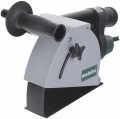Real power
The power delivered by the tool motor directly to the cutter or blade. The output power is inevitably less than the power input of the motor.
Note that in the characteristics of tools this parameter is given relatively rarely. However, it is he who most accurately describes the general capabilities of the unit, such as speed, the ability to make deep cuts and cope with hard materials. Therefore, it is best to compare different models with each other precisely in terms of output power.
This indicator also allows you to evaluate the overall efficiency: the higher the ratio of output power to the power consumption of the engine, the more efficiently the tool consumes energy / fuel.
Rotation speed
The maximum speed of rotation of the disk / cutter provided by the tool.
The higher the speed, the higher the speed of the cutting edge relative to the material, the higher the processing speed and the more accurate the cut is. On the other hand, as the speed increases, the torque decreases. So for the same blade/cutter diameter, higher RPMs will be beneficial on relatively soft materials, while a slower tool will be better for hard and stubborn materials.
Processing width
The width of the furrow that the tool can cut. This parameter is relevant for models with a cutter (see "Work item") and units with several discs (see "Working discs / cutters"). In the first case, the processing width corresponds to the width of the cutter, in the second — to the distance between the discs. This distance can be changed by installing special washers on the spindle; therefore, in many tools, the processing width is indicated by a range, from minimum to maximum.
Functions
—
Self -propelled. A feature found exclusively in joint cutters (see "Device"). Such a tool has a wheel drive and is able to move independently; the travel speed during operation adjusts to the cutting speed. At idle, it is also low; however, the self-propelled design saves a lot of operator effort, especially when it comes to powerful heavy units — for them wheel drive is almost a must.
—
Soft start. Function applicable to models with an electric motor (see "Type"). Without a soft start system, the motor consumes high current at the time of starting, which leads to noticeable voltage fluctuations in the network; and spinning up to operating speed occurs very quickly, with a jerk — as a result, if the hold is not strong enough, the tool can be released from the hands. Soft start avoids these phenomena: the control electronics limits the starting current, preventing power surges and sharp jerks of the tool.
—
Maintain momentum. Maintaining constant engine speed regardless of the load on the disc / cutter. For this, electronics are used that control the power of the engine: at a low load, the power decreases, and with an increase in resistance, it increases, due to which the speed of rotation of the disk / cutter remains unchanged. Working at a constant speed has a positive effect on both the quality of processing and the service life of the discs / cutters.
...
— Electronic engine protection. Control electronics to prevent damage to the tool when overloaded or overheated. In the event of critical situations, such a system turns off the power to the engine in order to avoid breakdowns. You may need to press the unlock button to continue working. Such protection is found only in electric motors (see "Type").
— Brushless motor. The presence of such an engine provides a number of advantages over traditional collector engines: in particular, they are more economical in terms of energy consumption, less noisy, and also do not spark, which can be important in conditions of increased fire danger. The disadvantages of brushless motors are complexity and high cost.
— Safety clutch. Special coupling located between the motor shaft and the spindle; may be disposable or reusable. With a critical increase in resistance on the disk / cutter (for example, if the disk is jammed), this clutch is destroyed or opened, preventing engine damage and sharp jerks of the tool. This type of protection is also found in electric tools and in units with internal combustion engines (see "Type").
— Laser marker. Indicator light showing where the cut line will go when the tool is moving straight ahead. This feature is especially convenient since the blade or cutter is usually hidden from the operator's eyes by a protective cover.Case included
The presence of a case in
the delivery set — a hard case that protects the instrument from dirt and contact with foreign objects. Complete cases are more convenient than impromptu packaging: they initially provide “seats” for both the tool and its accessories (replaceable discs / cutters, replacement keys, etc.).
Noise level
Approximate noise level produced by the instrument during operation (actual volume may vary depending on performance).
The lower the noise, the more comfortable the use of the tool, the easier it is to work with it without headphones or other noise protection equipment. It is easiest to evaluate a specific volume level using comparative tables. In general, wall chasers and jointers are quite noisy equipment — in most models, the volume exceeds 90 dB (loudness comparable to the sound of a moving freight car at 7 m), and in the most noisy this figure reaches 118 – 119 dB, which is only slightly below the human pain threshold . If the volume is more than 100 dB, it is highly recommended to use protective headphones or earplugs.

